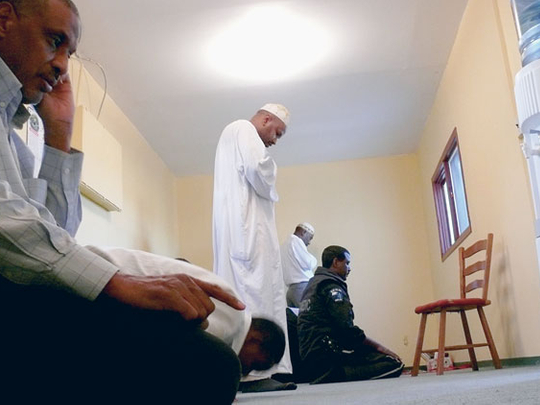
The cold, inky-black darkness lasts 30 days. Outside, the mercury is struggling to get above minus 32C. Inside the crowded nine-by-14-foot trailer, a few of the faithful gather for Dhuhr prayers, facing south and east, towards the Ka'abah. Virtually everything and everywhere is south of here, high above the Arctic Circle.
In winter, it can get as cold as minus 50C, cold enough to freeze unexposed skin in less than five minutes and make your nostrils tingle and lungs hurt at the sharp, raw air.
In summer, the Sun never sets for 55 days straight, making it difficult to determine time for Fajr and Maghrib prayers.
Welcome to Inuvik, in Canada's Northwest Territories (NWT), home to 3,200 residents, 100 or so of whom are Muslims.
This trailer-cum-mosque has been in use for the past decade but it is finally being replaced by a new one which arrived last month, shipped overland from Winnipeg, Manitoba, 4,000 kilometres away to the south. Inuvik is the closest town to the North Pole, just 2,400 kilometres away.
It is the northern-most mosque in the world.
Because the old mosque was too small and could only accommodate less than one fifth of them at any one time, the Muslim community celebrated Eid Al Fitr in the lounge of the town's curling club. As the community celebrated the end of Ramadan, local curling enthusiasts slid their granite rocks down the length of the ice rink, with sweepers brushing the ice to help with speed and direction. Incantations of "Allahu Akbar" were interspersed with curlers' cries of "Hurry hard".
Now the arrival of the new mosque has changed all of that.
"It's a symbolic place for the Muslims," explained Mamdouh Al Haradi, a native of Sudan and one of the town's taxi drivers. Indeed, all of Inuvik's taxi drivers are Muslim. "It means that if anybody comes up here, they'll find a place to pray and worship. Plus, we're planning on using it as a community centre."
In the past decade, Inuvik has mushroomed with oil and energy exploration, with heavy rigs and equipment shipped in during winter over dangerous ice roads. The local Muslim community banded together and managed to raise enough money to buy two plots in the permafrost for the new mosque. But with limited support and having to send children south for Islamist education and culture, there was little chance of raising funds for the new mosque.
But all that changed in a chance encounter with Hussain Guisti, who runs the Manitoba-based Zubaidah Tallab Foundation, an Islamic charity established to perform good works on behalf of his late mother-in-law.
"We don't turn down any project that strives to help the poor and the needy and to serve the community," Guisti explained recently.
Building a prefabricated mosque and shipping it north to Inuvik was just the kind of challenge the Zubaidah Tallab Foundation relished. Raising C$300,000 (Dh1,080,000) for the project was the easy bit, relatively speaking. Getting the structure north, by truck and barge, was the difficult work.
"We were told: ‘You know, this can't be done. It's impossible. There's no way you're going to get it there in one piece.' To know that I did it — it's a feeling of joy," Guisti said.
The challenge was to move the 1,550-square-foot structure in one piece from Winnipeg to the Arctic Circle across two provinces and sailing it on a barge from Hay River down the Mackenzie River — a 4,000-kilometre trip over some of the most desolate, isolated and rugged scenery in the world, certainly in North America.
The long road journey north began on September 1, the prefabricated mosque perched precariously on the back of a semi-trailer.
Because of power lines, traffic regulations, transport red tape, high winds, narrow bridges and other physical structures in the way, the mosque was specially designed and could only move during limited off-peak periods.
Originally, the movers expected to have 30 days to ship the mosque by road to Hay River, then switch to a barge for a gentle 1,800-kilometre voyage down the Mackenzie River to Inuvik.
But the weather in northern Canada is unpredictable — the only sure thing is that winters are long, cold and can change at any time.
And that's exactly what was happening up north. The mosque had to be at Hay River before September 10, after which the water level would be too low for the voyage down the Mackenzie; if the barge was delayed, there was every chance it would be ice-bound in the river for the long, deep, dark winter months.
On a narrow bridge in the middle of the tundra between Alberta and NWT, the entire project came within inches of being scuttled. As two trucks tried to move the mosque over a narrow bridge, the mosque slipped to one side of the flatbed trailer and appeared to be headed into Reindeer Creek.
"We almost had an underwater mosque, a house of worship for toads and fish," Guisti recounted. "That was close."
The mosque was saved by a construction crew, which was nearby and had the equipment on hand to move the ten-metre-wide load back on to the flatbed.
And even though the barge was racing at a snail's pace to meet the barge deadline, officials in Edmonton stopped the shipment for a day because of safety concerns.
But for every obstacle that was thrown up, somehow the mosque made it.
After 23 days, the mosque docked at Inuvik, just as the first flakes of winter snow began to gather on the ground.
"It's a beautiful building," said Amir Sulaiman, as he watched the mosque make landfall and onlookers stomped their feet to keep warm. "Everyone's happy to have this small home for meeting and for prayer, and for the children to be playing in."
With inputs from wire agencies.












